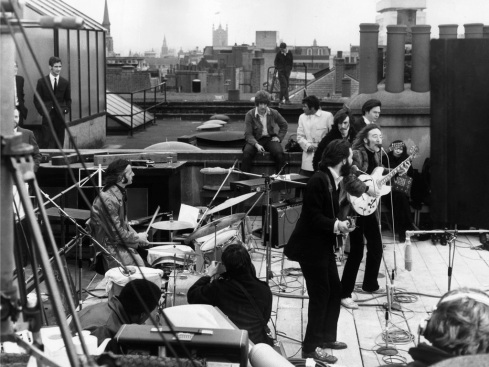The idea of “taking a line for a walk” comes from one of Birtwistle’s favourite artists, Paul Klee. A preoccupation with Klee and his theories was an inspiration for one of the definitive Birtwistle pieces of the late 1970s, Carmen Arcadiae Mechanicae Perpetuum. Using Klee’s idea of the difference between “dividual” and “individual” phenomena – the difference between, say, the endlessly divisible nature of water, as opposed to the singularity, the indivisibility, of a bottle of water – Birtwistle conjured a series of different musical materials. The question was then how to repeat these blocks of material, and how to transform them. On their own, each block is like a little machine of processes and patterns, but nothing ever repeats in quite the way you expect. That’s because Birtwistle used a series of random numbers to help generate how the blocks would recur, how long they would last, and even what notes they would use.
And here’s the paradox. “I didn’t make any decisions in writing Carmen,” Birtwistle says, since so much of the structure was generated through random procedures, “and yet it sounds like me – and no one else could have written it.”
Whilst there are a few works of Boulez I find to be very mediocre (Derive, Mémoriale, (“…explosante-fixe…”), both Incises and Sur Incises, and a few others), and I’m by no means convinced that various lush re-orchestrations of earlier works constitute an improvement, nonetheless he remains one of the most significant figures of the second half of the 20th century to me, and one whose work shows a greater consistency across the breadth of his output than, say, that of Stockhausen (who spent about 35 years mostly up his own arse, slowly going mad, with just the odd decent work).
All of this is to ignore Boulez’s seminal role as conductor, apologist for not just “new music” but for Debussy’s (for instance), Messiaen’s, Alban Berg’s, and a host of others. He established perhaps the most important institute for electronic and computer music research in the world, single-handedly petitioning a thankfully enlightened French Government in the late 60s/early 70s.
He renovated the repertoire, established a benchmark in certain conducting techniques (perhaps not to everyone’s taste, but it enlivened the world of the symphony orchestra and shook up the BBCSO), released superlative recordings of some of the 20th century’s greatest music, was politically active in supporting young composers, new music more generally, educational standards and notions of musical citizenship, and worked outside the box with the likes of the genius Frank Zappa.
The Second String Quartet was composed when Janáček was 74, in the last year of his life. Listening to this music full of fresh, dramatic, and passionate musical ideas, one almost refuses to believe the age of the composer. But his inspiration was profound; it stemmed from his strong, fateful attraction to a young woman, Kamila Stösslová.
Janáček knew that such a strong emotional experience is not a guarantee of the origin of a great musical work. He wrote to Kamila:
“Sometimes the feeling itself is so overwhelming and strong that notes hide under it and flee. Great love – weak music. And I would like: Great love – glorious music!”
(Taken from The Book of Knowledge, edited by Harold F.B. Wheeler)
Many are the tales the Chinese tell of the wonderful cures that ginseng has wrought. They will tell you that its roots are a remedy for every illness, that they are able to prolong life and even to restore it after death; and their legends recount how the wolf, tiger, snake, and panda protect this miraculous plant from harm, and how the roots save themselves from capture by moving from place to place underground. And so, although our own physicians regard it as of little value, Johnny Chinaman still buys it at any price.
The most valuable ginseng – sometimes worth £10 an ounce – comes from Korea and Manchuria, and an inferior quality is cultivated in Japan. Most of the wild ginseng has now disappeared, and a cultivated plant is taking its place.
But the wild variety always commands better prices, because of the Chinese superstition which prefers roots resembling a man or some grotesque being (ginseng means “form of man”) rather than the regular roots which cultivation tends to produce. As shown above, the most fantastic shapes of men, animals, and wild birds are often dug up.
Ginseng belongs to the genus Panax. Panax ginseng, a native of China, and Panax quinquefolium, of eastern North America, are the most noted species.
Benjamin Britten famously said that he would sometimes play “the whole of Brahms” (whatever that means) just to remind himself how bad it was. Britten was an arse bandit. Perhaps this explains Peter Pears’ strangulated voice.
I also remember a quote by Ken Russell that Brahms’ music reminded him of Victorian sepia photographs.
It’s interesting that most people associate Brahms with his chamber and orchestral works, when around three-quarters of his output includes voices. Many, many songs (countless treasures in there), numerous works for multiple solo voices and instruments, and much for choir (Brahms conducted several choirs through the course of his lifetime) and choir and orchestra.
I tend to believe that the problem with a lot of Brahms performance lies not so much with the use of vibrato, larger orchestras, modern pianos, or whatever (all of which Brahms experienced on occasion), but the approaches to phrasing and articulation – already problematic in editions appearing soon after his death (for example those of the piano music by Sauer) which tend to smooth out the many very subtle details Brahms notated, and replace his sometimes fragmentary and delicate approach to the balance between small-scale units and longer lines with a rather homogenous approach stressing maximum continuity.
The rests are very important (Brahms took immense care over them when preparing editions); many pedal markings in others’ editions of the piano music make little sense, nor do some conductors’ attempts to artificially make contrasting fragments cohere into a continuous whole, negating some of the inner tensions.
There are indeed some composers whose work is more likely than that of others to invite extreme reactions, although I would not immediately single out Brahms as a particularly notable example, for all that there are some for whom he could do no wrong and others who detest much of his work – in other words, I’m less than convinced that these extreme positions vis-à-vis Brahms are especially common. Britten’s loathing of Brahms, whilst well known, was by no means universal; he had, for example, a lot of time for the D minor piano concerto. I happen to think it’s dull.
Delius strikes me as one example of a composer whose work tends to elicit mostly very positive or very negative responses; Havergal Brian is another. Why it is that certain composers’ works more often than not tend to attract these extreme reactions is quite another matter.
Speaking personally, I love Brahms’ music.









Recent Comments